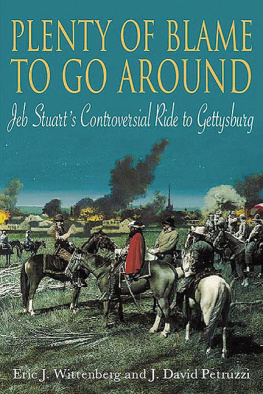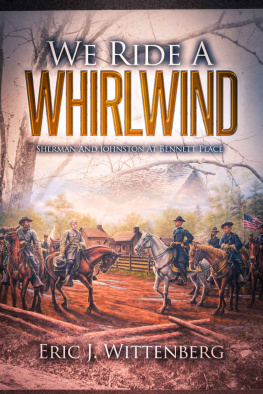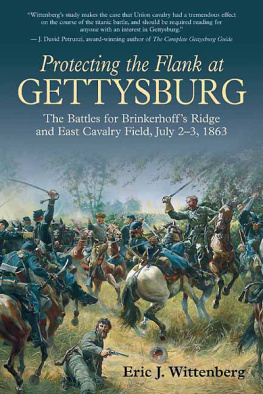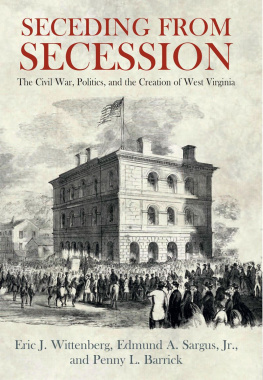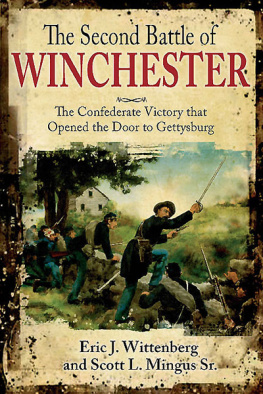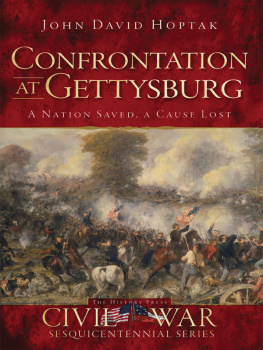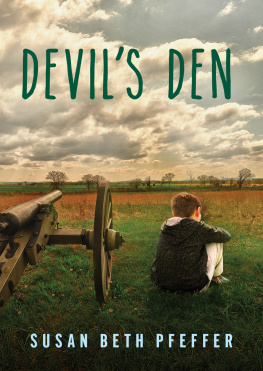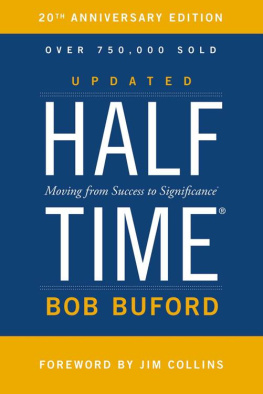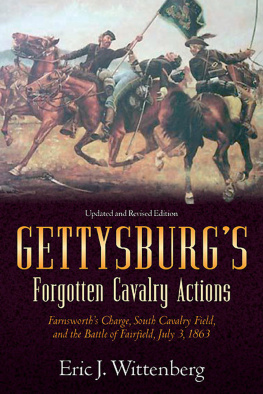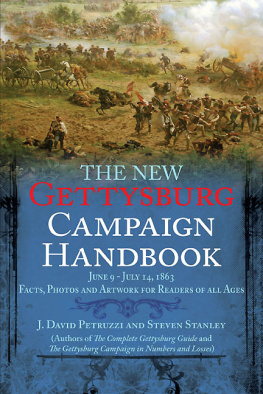The Devils to Pay
John Buford at Gettysburg
A History and Walking Tour
Eric J. Wittenberg
Savas Beatie
California
2014 by Eric J. Wittenberg
All rights reserved. No part of this publication may be reproduced, stored in a retrieval system, or transmitted, in any form or by any means, electronic, mechanical, photocopying, recording, or otherwise, without the prior written permission of the publisher.
Library of Congress Cataloging-in-Publication Data
Wittenberg, Eric J., 1961-
The Devils to pay : John Buford at Gettysburg : a history and tour guide / Eric J.
Wittenberg.
pages cm
Includes bibliographical references and index.
ISBN 978-1-61121-208-2
1. Gettysburg, Battle of, Gettysburg, Pa., 1863. 2. Buford, John, 1826-1863. 3.
PennsylvaniaHistoryCivil War, 1861-1865Cavalry operations. 4. United
StatesHistoryCivil War, 1861-1865Cavalry operations. 5. Gettysburg National
Military Park (Pa.)Tours. I. Title.
E475.53.W756 2014
973.7349dc23
2014032494
Published by
Savas Beatie LLC
989 Governor Drive, Suite 102
El Dorado Hills, CA 95762
Phone: 916-941-6896
(E-mail) customerservice@savasbeatie.com
05 04 03 02 01 5 4 3 2 1
First edition, first printing
Savas Beatie titles are available at special discounts for bulk purchases in the United States by corporations, institutions, and other organizations. For more details, please contact Special Sales, P.O. Box 4527, El Dorado Hills, CA 95762, or you may e-mail us at sales@savasbeatie.com, or visit our website at www.savasbeatie.com for additional information.
Proudly published, printed, and warehoused in the United States of America.
Buford is dead!
No more to follow his daring form
Or see him dash through the battles storm;
No more with him to ride down the foe.
And behold his falchions crushing blow.
Nor hear his voice, like a rushing blast.
As rider and steed went charging past
Buford is dead!
Rock Island Argus, March 10, 1896
Other works by Eric J. Wittenberg
We Have it Damned Hard Out Here: The Civil War Letters of Sgt. Thomas W. Smith, Sixth Pennsylvania Cavalry (1999)
One of Custers Wolverines: The Civil War Letters of Brevet Brigadier General James H. Kidd, 6th Michigan Cavalry (2000)
Under Custers Command: The Civil War Journal of James Henry Avery (2000)
At Custers Side: The Civil War Writings of James Harvey Kidd (2001)
Glory Enough for All: Sheridans Second Raid and the Battle of Trevilian Station (2001)
With Sheridan in the Final Campaign Against Lee (2002)
Little Phil: A Reassessment of the Civil War Leadership of Gen. Philip H. Sheridan (2002)
The Union Cavalry Comes of Age: Hartwood Church to Brandy Station, 1863 (2003)
The Battle of Monroes Crossroads and the Civil Wars Final Campaign (2006)
Plenty of Blame to Go Around: Jeb Stuarts Controversial Ride to Gettysburg (with J. David Petruzzi, 2006)
Rushs Lancers: The Sixth Pennsylvania Cavalry in the Civil War (2007)
One Continuous Fight: The Retreat from Gettysburg and the Pursuit of Lees Army of Northern Virginia, July 4-14, 1863 (with J. David Petruzzi and Michael F. Nugent, 2008)
Like a Meteor Blazing Brightly: The Short but Controversial Life of Colonel Ulric Dahlgren (2009)
The Battle of Brandy Station: North Americas Largest Cavalry Battle (2010)
Gettysburgs Forgotten Cavalry Actions: Farnsworths Charge, South Cavalry Field and the Battle of Fairfield (Second Edition, 2011)
The Battle of White Sulphur Springs; Averell Fails to Secure West Virginia (2011)
Protecting the Flank at Gettysburg: The Battles for Brinkerhoffs Ridge and East Cavalry Field (Second Edition, 2013)
Authors Preface
Like so many other Pennsylvania school children, I made my first visit to Gettysburg as a third-grader. Like most impressionable children, the giant boulders of Devils Den left a prominent mark on my imagination. But so, too, did the heroic stand by the dismounted cavalrymen of Brig. Gen. John Bufords First Cavalry Division. The three most prominent memories I have of that first visit are of Devils Den, the story of John Bufords stand on the first day, and the death of Maj. Gen. John Fulton Reynolds that bloody, fateful morning. I have vivid memories of being fascinated by the story of how Bufords badly outnumbered horse soldiers successfully held off the bulk of an entire corps of Confederate infantry for several hours, steadfastly resisting the Confederate advance until Reynolds and the Army of the Potomacs First Corps arrived on the field just in the nick of time. Hence, my fascination with the exploits of Bufords troopers dates back to my very first visit to Gettysburg as a 9-year-old.
I carry that fascination with me well into middle age. I have spent my adult life chronicling the exploits of the horse soldiers of the Civil War. I have written 17 books and dozens of articles on the topic, but in the end, I always come back to my first fascination, the story of Buford and his troopers. In the intervening years, I have periodically revisited Bufords command and its exploits with a number of articles and several books that touch on these men and what they accomplished. However, until now, I have never tried to do a monograph on the critical role of Bufords division at Gettysburg. Having documented the remaining cavalry actions at Gettysburg, I realized that my efforts to document all of the engagements involving the cavalry in this critical campaign would not be complete unless I filled that gap. Accordingly, I came to the conclusion that the time had come to do so. This is the story that I have waited my entire life to tell.
In this volume, I will introduce the reader to John Buford and the men he led, including his outstanding brigade commanders, Colonels William Gamble and Thomas C. Devin, as well as to Lt. John H. Calef, the talented young West Pointer who commanded the battery of horse artillery assigned to Bufords division. A brief overview of Bufords role in the Gettysburg Campaign to date, from its beginning on June 3, 1863 to the night of June 29, follows. A detailed tactical discussion of Bufords prominent role in the Battle of Gettysburg then follows, covering the events beginning on June 30, 1863 and ending with the withdrawal of the First Cavalry Division from Gettysburg on July 2. It concludes with an analysis of the critical role played by the quiet Kentuckian and his troopers. There are four appendices. The first is an order of battle timed for 9:15 a.m. on July 1, 1863. The second addresses the persistent myth that Bufords men were armed with repeating rifles at Gettysburg. The third addresses the question of the precise nature of the defense designed and conducted by Buford. The fourth addresses another persistent question, of whether Confederate infantry formed hollow squares to defend against a feinted mounted charge by Bufords two brigades. Finally, I include a driving/walking tour of sites associated with John Bufords stand at Gettysburg that includes GPS coordinates.
As with any project of this nature, I am grateful to any number of people for their assistance. I am especially grateful to my friend, co-author, and fellow cavalry historian, J. David Petruzzi, for writing the foreword that follows and for his invaluable assistance with sources and with reviewing this manuscript for me. My friend Daniel Mallock read the manuscript for me as to readability and as to coherence. William B. Styple of Kearny, New Jersey provided images from the dedication of the Buford monument on the battlefield at Gettysburg and some useful tidbits from the James E. Kelly papers. Marshall Krolick, the authority on all things pertaining to the 8th Illinois Cavalry, provided material and the image of Col. William Gamble that graces these pages. John Heiser and Greg Goodell, who are both rangers at Gettysburg, provided useful material, and so did Lauren Roedner, the archivist at the Adams County Historical Society. James Hessler, the authority on Dan Sickles at Gettysburg, gave me good and useful feedback on the three chapters that dealt with Bufords role on the second day of the battle, and I appreciate his assistance. Rick Wolfe and Joe Stahl both provided me with images that have never before been published but which appear here for the first time. Philip Laino drew the excellent maps that fill this volume, and Phils maps make this a better book. Steve L. Zerbe and Bryce Suderow helped gather the research material that fills these pages.





